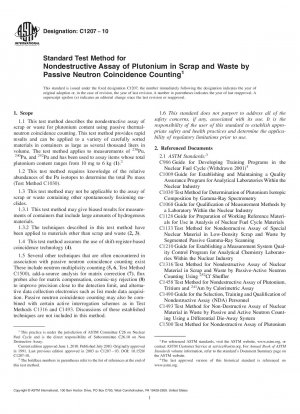ASTM C1207-10
Standard Test Method for Nondestructive Assay of Plutonium in Scrap and Waste by Passive Neutron Coincidence Counting
- Standard No.
- ASTM C1207-10
- Release Date
- 2010
- Published By
- American Society for Testing and Materials (ASTM)
- Status
- Replace By
- ASTM C1207-10(2018)
- Latest
- ASTM C1207-10(2018)
- Scope
This test method is useful for determining the plutonium content of scrap and waste in containers ranging from small cans with volumes of the order of a mL to crates and boxes of several thousand liters in volume. A common application would be to 208-L (55-gal) drums. Total Pu content ranges from 10 mg to 6 kg (1). The upper limit may be restricted depending on specific matrix, calibration material, criticality safety, or counting equipment considerations.
This test method is applicable for U.S. Department of Energy shipper/receiver confirmatory measurements (9), nuclear material diversion detection, and International Atomic Energy Agency attributes measurements (10).
This test method should be used in conjunction with a scrap and waste management plan that segregates scrap and waste assay items into material categories according to some or all of the following criteria: bulk density, the chemical forms of the plutonium and the matrix, americium to plutonium isotopic ratio, and hydrogen content. Packaging for each category should be uniform with respect to size, shape, and composition of the container. Each material category might require calibration standards and may have different Pu mass limits.
Bias in passive neutron coincidence measurements is related to item size and density, the homogeneity and composition of the matrix, and the quantity and distribution of the nuclear material. The precision of the measurement results is related to the quantity of nuclear material, the (α,n) reaction rate, and the count time of the measurement.
For both benign matrix and matrix specific measurements, the method assumes the calibration reference materials match the items to be measured with respect to the homogeneity and composition of the matrix, the neutron moderator and absorber content, and the quantity of nuclear material, to the extent they affect the measurement.
Measurements of smaller containers containing scrap and waste are generally more accurate than measurements of larger items.
It is recommended that where feasible measurements be made on items with homogeneous contents. Heterogeneity in the distribution of nuclear material, neutron moderators, and neutron absorbers have the potential to cause biased results.
The coincident neutron production rates measured by this test method are related to the mass of the even number isotopes of plutonium. If the relative abundances of these isotopes are not accurately known, biases in the total Pu assay value will result.
Typical count times are in the range of 300 to 3600 s.
Reliable results from the application of this method require training of the personnel who package the scrap and waste prior to measurement and of personnel who perform the measurements. Training guidance is available from ANSI 15.20, Guides , C1009, C1068, and C1490.
1.1 This test method describes the nondestructive assay of scrap or waste for plutonium content using passive thermal-neutron coincidence counting. This test method provides rapid results and can be applied to a variety of carefully sorted materials in containers as large as several thousand liters in volume. The test method applies to measurements of 238Pu, 240Pu, and 242Pu and has been used to assay items whose total plutonium content ranges from 10 mg to 6 kg (1).
1.2 This test method requires knowledge of the rel......
ASTM C1207-10 Referenced Document
- ASTM C1009 Standard Guide for Establishing a Quality Assurance Program for Analytical Chemistry Laboratories Within the Nuclear Industry
- ASTM C1030 Standard Test Method for Determination of Plutonium Isotopic Composition by Gamma-Ray Spectrometry
- ASTM C1068 Standard Guide for Qualification of Measurement Methods by a Laboratory Within the Nuclear Industry
- ASTM C1128 Standard Guide for Preparation of Working Reference Materials for Use in the Analysis of Nuclear Fuel Cycle Materials
- ASTM C1133 Standard Test Method for Nondestructive Assay of Special Nuclear Material in Low Density Scrap and Waste by Segmented Passive Gamma-Ray Scanning
- ASTM C1210 Standard Guide for Establishing a Measurement System Quality Control Program for Analytical Chemistry Laboratories Within the Nuclear Industry
- ASTM C1316 Standard Test Method for Nondestructive Assay of Nuclear Material in Scrap and Waste by Passive-Active Neutron Counting Using a 252 Cf Shuffler
- ASTM C1458 Standard Test Method for Nondestructive Assay of Plutonium, Tritium and&x2009;241Am by Calorimetric Assay*, 2024-04-19 Update
- ASTM C1490 Standard Guide for the Selection, Training and Qualification of Nondestructive Assay (NDA) Personnel
- ASTM C1493 Standard Test Method for Non-Destructive Assay of Nuclear Material in Waste by Passive and Active Neutron Counting Using a Differential Die-Away System
- ASTM C1500 Standard Test Method for Nondestructive Assay of Plutonium by Passive Neutron Multiplicity Counting
- ASTM C1592 Standard Guide for Nondestructive Assay Measurements
- ASTM C1673 Standard Terminology of C26.10 Nondestructive Assay Methods
- ASTM C986 Standard Guide for Developing Training Programs in the Nuclear Fuel Cycle
ASTM C1207-10 history
- 2018 ASTM C1207-10(2018) Standard Test Method for Nondestructive Assay of Plutonium in Scrap and Waste by Passive Neutron Coincidence Counting
- 2010 ASTM C1207-10 Standard Test Method for Nondestructive Assay of Plutonium in Scrap and Waste by Passive Neutron Coincidence Counting
- 2003 ASTM C1207-03 Standard Test Method for Nondestructive Assay of Plutonium in Scrap and Waste by Passive Neutron Coincidence Counting
- 1997 ASTM C1207-97 Standard Test Method for Nondestructive Assay of Plutonium in Scrap and Waste by Passive Neutron Coincidence Counting
